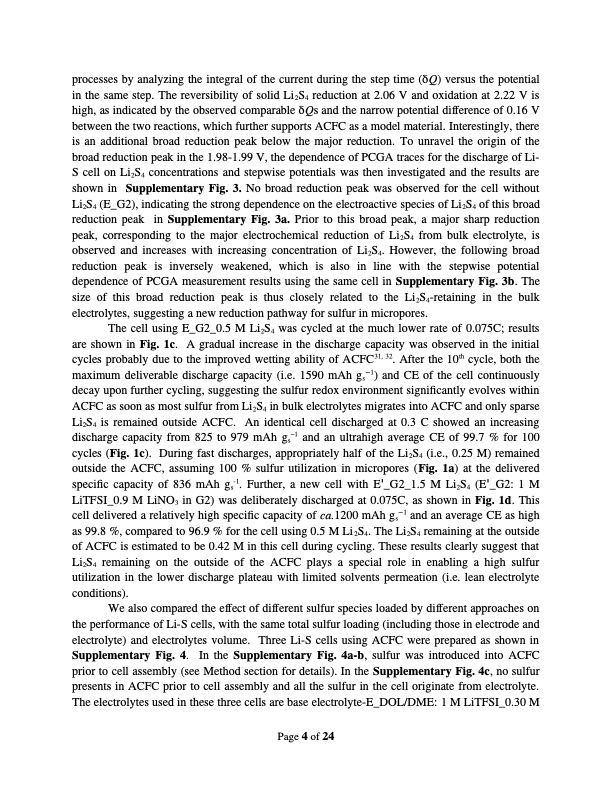
PDF Publication Title:
Text from PDF Page: 004
processes by analyzing the integral of the current during the step time (δQ) versus the potential in the same step. The reversibility of solid Li2S4 reduction at 2.06 V and oxidation at 2.22 V is high, as indicated by the observed comparable δQs and the narrow potential difference of 0.16 V between the two reactions, which further supports ACFC as a model material. Interestingly, there is an additional broad reduction peak below the major reduction. To unravel the origin of the broad reduction peak in the 1.98-1.99 V, the dependence of PCGA traces for the discharge of Li- S cell on Li2S4 concentrations and stepwise potentials was then investigated and the results are shown in Supplementary Fig. 3. No broad reduction peak was observed for the cell without Li2S4 (E_G2), indicating the strong dependence on the electroactive species of Li2S4 of this broad reduction peak in Supplementary Fig. 3a. Prior to this broad peak, a major sharp reduction peak, corresponding to the major electrochemical reduction of Li2S4 from bulk electrolyte, is observed and increases with increasing concentration of Li2S4. However, the following broad reduction peak is inversely weakened, which is also in line with the stepwise potential dependence of PCGA measurement results using the same cell in Supplementary Fig. 3b. The size of this broad reduction peak is thus closely related to the Li2S4-retaining in the bulk electrolytes, suggesting a new reduction pathway for sulfur in micropores. The cell using E_G2_0.5 M Li2S4 was cycled at the much lower rate of 0.075C; results are shown in Fig. 1c. A gradual increase in the discharge capacity was observed in the initial cycles probably due to the improved wetting ability of ACFC31, 32. After the 10th cycle, both the maximum deliverable discharge capacity (i.e. 1590 mAh gs−1) and CE of the cell continuously decay upon further cycling, suggesting the sulfur redox environment significantly evolves within ACFC as soon as most sulfur from Li2S4 in bulk electrolytes migrates into ACFC and only sparse Li2S4 is remained outside ACFC. An identical cell discharged at 0.3 C showed an increasing discharge capacity from 825 to 979 mAh gs−1 and an ultrahigh average CE of 99.7 % for 100 cycles (Fig. 1c). During fast discharges, appropriately half of the Li2S4 (i.e., 0.25 M) remained outside the ACFC, assuming 100 % sulfur utilization in micropores (Fig. 1a) at the delivered specific capacity of 836 mAh gs-1. Further, a new cell with Eꞌ_G2_1.5 M Li2S4 (Eꞌ_G2: 1 M LiTFSI_0.9 M LiNO3 in G2) was deliberately discharged at 0.075C, as shown in Fig. 1d. This cell delivered a relatively high specific capacity of ca.1200 mAh gs−1 and an average CE as high as 99.8 %, compared to 96.9 % for the cell using 0.5 M Li2S4. The Li2S4 remaining at the outside of ACFC is estimated to be 0.42 M in this cell during cycling. These results clearly suggest that Li2S4 remaining on the outside of the ACFC plays a special role in enabling a high sulfur utilization in the lower discharge plateau with limited solvents permeation (i.e. lean electrolyte conditions). We also compared the effect of different sulfur species loaded by different approaches on the performance of Li-S cells, with the same total sulfur loading (including those in electrode and electrolyte) and electrolytes volume. Three Li-S cells using ACFC were prepared as shown in Supplementary Fig. 4. In the Supplementary Fig. 4a-b, sulfur was introduced into ACFC prior to cell assembly (see Method section for details). In the Supplementary Fig. 4c, no sulfur presents in ACFC prior to cell assembly and all the sulfur in the cell originate from electrolyte. The electrolytes used in these three cells are base electrolyte-E_DOL/DME: 1 M LiTFSI_0.30 M Page 4 of 24PDF Image | A lithium-sulfur battery with a solution-mediated pathway

PDF Search Title:
A lithium-sulfur battery with a solution-mediated pathwayOriginal File Name Searched:
qt9bt5f7wt_noSplash_4e336387563ecb2106bd171b37448483.pdfDIY PDF Search: Google It | Yahoo | Bing
Sulfur Deposition on Carbon Nanofibers using Supercritical CO2 Sulfur Deposition on Carbon Nanofibers using Supercritical CO2. Gamma sulfur also known as mother of pearl sulfur and nacreous sulfur... More Info
CO2 Organic Rankine Cycle Experimenter Platform The supercritical CO2 phase change system is both a heat pump and organic rankine cycle which can be used for those purposes and as a supercritical extractor for advanced subcritical and supercritical extraction technology. Uses include producing nanoparticles, precious metal CO2 extraction, lithium battery recycling, and other applications... More Info
| CONTACT TEL: 608-238-6001 Email: greg@infinityturbine.com | RSS | AMP |